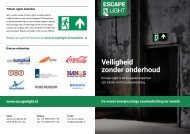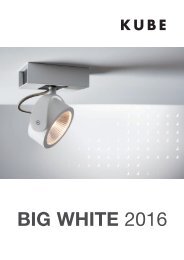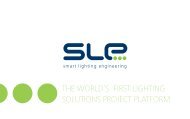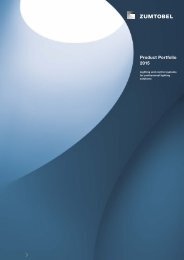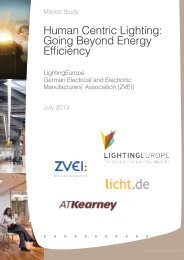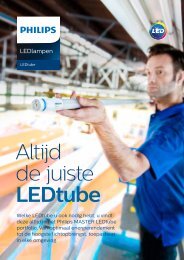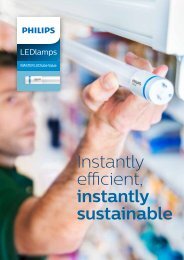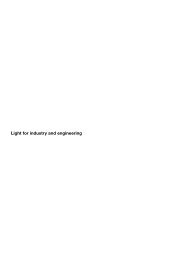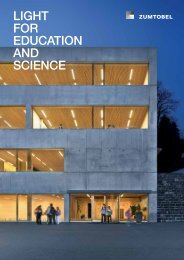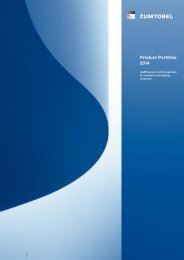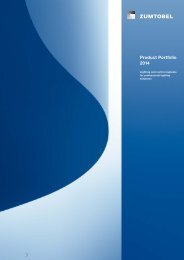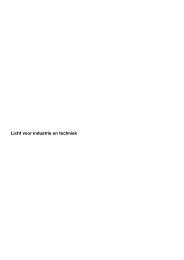Tritium-Light-presentation-English
You also want an ePaper? Increase the reach of your titles
YUMPU automatically turns print PDFs into web optimized ePapers that Google loves.
<strong>Tritium</strong> <strong>Light</strong>s<br />
Non-electrical and maintenance free<br />
escape route signs
What are <strong>Tritium</strong> <strong>Light</strong>s?<br />
• Escape route signs with the name<br />
<strong>Tritium</strong> <strong>Light</strong>s, for instance for<br />
application in places where no<br />
electricity is available.<br />
• For internal illumination tritium gas (an<br />
isotope of hydrogen) is used as an<br />
energy source, which decays from an<br />
instable to a stable condition.<br />
• The decay energy is transformed into<br />
light by means of a phosphor.
Technology<br />
• <strong>Tritium</strong> <strong>Light</strong>s emergency signs are illuminated with light sources that consist<br />
of glass tubes, that have been internally coated with phosphor and filled with<br />
tritium gas.<br />
• <strong>Tritium</strong> gas (3H) is an isotope of hydrogen that emits low<br />
energy radiation in the form of beta rays, or electrons.<br />
• These electrons stimulate the phosphor coating causing<br />
the tubes to continuously emit light.<br />
• The mechanism is exactly the same as an electrical fluorescent lamp with the<br />
only exception being that the electrons are provided by the tritium gas rather<br />
than by an electric current.<br />
• In this way <strong>Tritium</strong> <strong>Light</strong>s emergency signs require no external energy source<br />
and, as such, are the most energy efficient lighting products available today.
Meeting Rules & Regulations?<br />
Yes! <strong>Tritium</strong> <strong>Light</strong>s are meeting standards such as:<br />
• ANSI N540<br />
• NFPA Life Safety Code 101<br />
• Euopean directive 92/58 EEG, BS-5499 part 2<br />
• NEN-EN 1838<br />
• NEN 6088<br />
• NEN-EN-ISO 7010<br />
• Bouwbesluit (Dutch 'Technical Building<br />
Code’)<br />
The measured recognition distances are as follows:<br />
• Illuminance of < 1 lux (darkness): 31.8 m.<br />
• Illuminance of approx. 10 lux (emergency lighting): 36.8 m.<br />
• Illuminance of approx. 250 lux (normal interior lighting): 44.4 m.<br />
These recognition distances comply amply with standard NEN 6088:2002 (requiring at least <br />
20 m), which is based on a minimum height of the escape route sign of 100 mm.<br />
The luminous intensity of the tritium gas light source decreases very slowly: after 12.3 years the<br />
activity is 50% of the original activity. Actually, the luminous intensity decreases slower than the<br />
activity.<br />
Therefore the effective lifetime is 15 years. <strong>Tritium</strong> <strong>Light</strong>s complies abundantly with the minimum<br />
duration period of one hour (standard NEN-EN 1838).
Are <strong>Tritium</strong> <strong>Light</strong>s safe?<br />
Yes!<br />
The beta particles are completely contained within the glass tubes which are protectively housed<br />
within the frame of the sign.<br />
In the Code of Federal Regulations, Title 10, Part 20, the U.S. government has set the acceptable<br />
limit for radiation exposure from man-made sources at 300 millirem (= 3 mSv) per year for the<br />
general public.<br />
Therefore, as shown in the graph, even in the unlikely event that an a tube or even a sign is<br />
broken**, there is no significant health risk.<br />
This chart depicts some of the everyday radiation that we are exposed to in the course of our<br />
normal existence.<br />
A <strong>Tritium</strong> <strong>Light</strong> breaks<br />
Living in a big city<br />
Cardiac stress test<br />
Upper or lower gastrointestinal test<br />
Smoking cigarettes (20 per day)<br />
* The scale of the chart runs from 0-8700 millirem.<br />
** We have made very conservative assumptions: a person exposed<br />
continuously for one hour in a small closed area (3 x 3 meter) with<br />
low ventilation (less than 1 air change per hour). In this scenario the<br />
radiation dose to the individual is approximately 30 millirem.<br />
To put this in perspective, this is roughly the equivalent to the<br />
radiation exposure received from one dental X-Ray.<br />
In a more realistic situation, the signs will typically be installed in<br />
hallways and larger rooms where the ventilation rates would be far<br />
higher and the personal exposure would be significantly shorter than<br />
that used in the above calculation.<br />
In these real life situations, the radiation exposure would be less<br />
than 10 millirem.
Advantages<br />
• Self-powered: Continuous, uninterrupted, high brightness<br />
illumination that requires no external energy source.<br />
• Energy efficient: Consumes NO electrical energy during their<br />
effective life of 15 years.<br />
• Don't need wiring: No need to install costly conduit or electrical wiring. Excellent for<br />
existing and monumental buildings.<br />
• Maintenance free: Simple, one time installation. There are no defective circuits, batteries,<br />
or lamps to check or replace. No self-test system required.<br />
• Explosion proof: Contains no electrical components. No spark or arcing. Ideal for<br />
hazardous locations, e.g. oil platforms, refineries and gas stations.<br />
• Shockproof: Unaffected by building or machinery vibrations. Ideal for use in ships and<br />
engine rooms.
Advantages<br />
• Waterproof: Unaffected by moisture. Ideal for wet or damp locations. Even under<br />
water! But also along highways and in tunnels.<br />
• Temperature-proof: Unaffected by extreme temperature variations. Tested from -60°C<br />
to +80°C. Ideal for cold or freezer applications.<br />
• EMC-unsensitive: They do not cause EMC interference and are unaffected by EMC<br />
from outside. Perfect for applications in hospitals and airplanes.<br />
• Very large viewing distance: They have a viewing distance of 44 meter according to <br />
NEN-EN-ISO 7010<br />
• Very long life: A minimum duration time of 15 years.
Costs<br />
<strong>Tritium</strong> <strong>Light</strong> escape signs have the<br />
lowest cost of ownership when<br />
compared to incandescent, compact<br />
fluorescent and LED exit signs over<br />
a 15-year period.<br />
* Cost comparison is based on Dutch figures, excluding VAT<br />
Notes:<br />
1. Average list price for a locally maintained escape<br />
route sign<br />
2. All-in labour cost € 45,- per hour<br />
3. 1 kWh = € 0,22<br />
4. Annual replacement (14x) à € 8,- / FL-lamp<br />
5. 15 minutes per replacement à € 45,- / hour<br />
6. Replacement of battery every 4 years à € 40,- /<br />
battery set<br />
7. 30 minutes per replacement à € 45,- / hour
References<br />
Other references (worldwide)<br />
• Boeing Corporation<br />
• DHL<br />
• Disney Corp.<br />
• Eurocontrol Maastricht Airport<br />
• General Electric Corp.<br />
• Harley Davidson<br />
• Hewlett-Packard<br />
• Hilton Hotels<br />
• IBM Corp.<br />
• Marina Seaport IJmuiden<br />
• Marriot Hotels<br />
• Proctor & Gamble Corp.<br />
• Stanford University<br />
• Tata Steel IJmuiden<br />
• UPS<br />
• and many more such as<br />
hospitals, churches,<br />
historical and national<br />
monument services
Contact<br />
Exclusive distributor Spain and Portugal, please contact<br />
Silke van Loenen<br />
+34 620 640 767<br />
European importer <strong>Tritium</strong> <strong>Light</strong>s: Escape <strong>Light</strong> B.V., Emmen, the Netherlands, www.escapelight.nl




